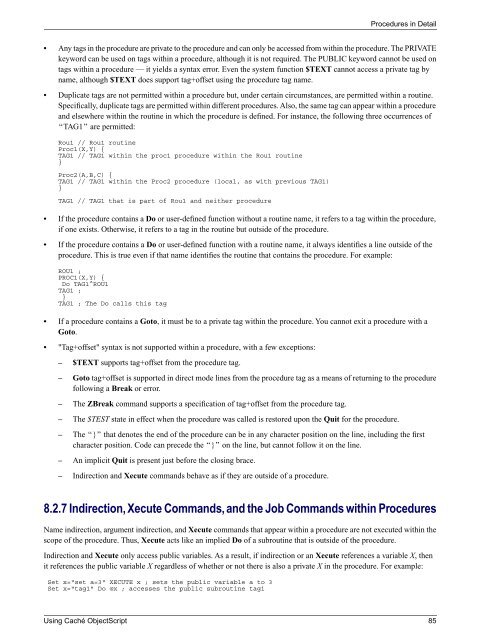Using Caché ObjectScript - InterSystems Documentation
Using Caché ObjectScript - InterSystems Documentation
Using Caché ObjectScript - InterSystems Documentation
Create successful ePaper yourself
Turn your PDF publications into a flip-book with our unique Google optimized e-Paper software.
Procedures in Detail<br />
• Any tags in the procedure are private to the procedure and can only be accessed from within the procedure. The PRIVATE<br />
keyword can be used on tags within a procedure, although it is not required. The PUBLIC keyword cannot be used on<br />
tags within a procedure — it yields a syntax error. Even the system function $TEXT cannot access a private tag by<br />
name, although $TEXT does support tag+offset using the procedure tag name.<br />
• Duplicate tags are not permitted within a procedure but, under certain circumstances, are permitted within a routine.<br />
Specifically, duplicate tags are permitted within different procedures. Also, the same tag can appear within a procedure<br />
and elsewhere within the routine in which the procedure is defined. For instance, the following three occurrences of<br />
“TAG1” are permitted:<br />
Rou1 // Rou1 routine<br />
Proc1(X,Y) {<br />
TAG1 // TAG1 within the proc1 procedure within the Rou1 routine<br />
}<br />
Proc2(A,B,C) {<br />
TAG1 // TAG1 within the Proc2 procedure (local, as with previous TAG1)<br />
}<br />
TAG1 // TAG1 that is part of Rou1 and neither procedure<br />
• If the procedure contains a Do or user-defined function without a routine name, it refers to a tag within the procedure,<br />
if one exists. Otherwise, it refers to a tag in the routine but outside of the procedure.<br />
• If the procedure contains a Do or user-defined function with a routine name, it always identifies a line outside of the<br />
procedure. This is true even if that name identifies the routine that contains the procedure. For example:<br />
ROU1 ;<br />
PROC1(X,Y) {<br />
Do TAG1^ROU1<br />
TAG1 ;<br />
}<br />
TAG1 ; The Do calls this tag<br />
• If a procedure contains a Goto, it must be to a private tag within the procedure. You cannot exit a procedure with a<br />
Goto.<br />
• "Tag+offset" syntax is not supported within a procedure, with a few exceptions:<br />
– $TEXT supports tag+offset from the procedure tag.<br />
– Goto tag+offset is supported in direct mode lines from the procedure tag as a means of returning to the procedure<br />
following a Break or error.<br />
– The ZBreak command supports a specification of tag+offset from the procedure tag.<br />
– The $TEST state in effect when the procedure was called is restored upon the Quit for the procedure.<br />
– The “}” that denotes the end of the procedure can be in any character position on the line, including the first<br />
character position. Code can precede the “}” on the line, but cannot follow it on the line.<br />
– An implicit Quit is present just before the closing brace.<br />
– Indirection and Xecute commands behave as if they are outside of a procedure.<br />
8.2.7 Indirection, Xecute Commands, and the Job Commands within Procedures<br />
Name indirection, argument indirection, and Xecute commands that appear within a procedure are not executed within the<br />
scope of the procedure. Thus, Xecute acts like an implied Do of a subroutine that is outside of the procedure.<br />
Indirection and Xecute only access public variables. As a result, if indirection or an Xecute references a variable X, then<br />
it references the public variable X regardless of whether or not there is also a private X in the procedure. For example:<br />
Set x="set a=3" XECUTE x ; sets the public variable a to 3<br />
Set x="tag1" Do @x ; accesses the public subroutine tag1<br />
<strong>Using</strong> <strong>Caché</strong> <strong>ObjectScript</strong> 85

















